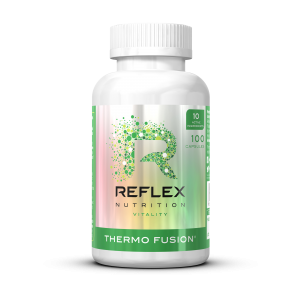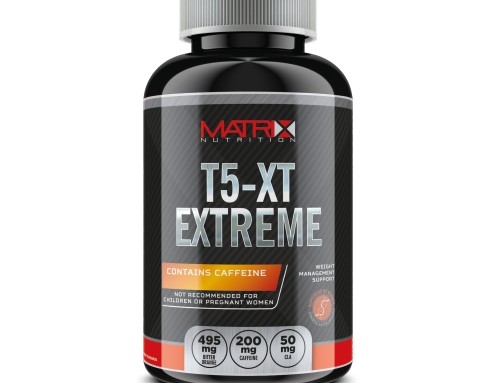Reflex Nutrition Thermo Fusion
Thermo Fusion is a supplement produced by UK based brand, Reflex Nutrition. This supplement is said to help with metabolism and blood glucose levels. This review will assess the ingredients listed within this supplement to identify whether these claims can be backed up.
Ingredients
DL-Phenylalanine
L-phenylalanine is an essential amino acid which is a precursor of melanin (1), dopamine (2) noradrenalin and thyroxine (3).
N-Acetyl-L-Carnitine / L-Carnitine
L-Carnitine is a dipeptide made from the essential amino acids lysine and methionine. L-Carnitine plays an important role in fat metabolism by allowing long chained fatty acids to pass through the mitochondrial membrane (4, 5).
L-Tartrate
L-tartrate is a form of L-carnitine. L-Carnitine is a dipeptide made from the essential amino acids lysine and methionine. L-Carnitine plays an important role in fat metabolism by allowing long chained fatty acids to pass through the mitochondrial membrane (6, 7).
Green Tea Extract (95% Polyphenols)
Green tea supplementation has been shown to have several health properties including an increase in plasma antioxidant which will lead to a lowering of oxidative damage (8, 9), decreased blood pressure (10, 11) and it can protect against coronary atherosclerosis (12). Other health effects that green tea can have includes a lowering of cholesterol, an increase of insulin activity (13) and a regulation of blood glucose levels which can help reduce body fat.
L-Choline Bitartrate
Choline is a water soluble nutrient that is naturally found within the body in small doses. the health benefits of choline are that it helps prevent fatty liver damage (14) as well as a lowering in cholesterol (15). It is used by athletes who believe it can delay fatigue however some studies have shown this not to be the case (16).
Cayenne Pepper Extract (0.5% Capsaicin) / Piperine (Bioperine®)
Pepper extract has numerous health benefits including helping with weight management by assisting with the breaking down and blocking the creation of fat cells (17), assisting with digestion by increasing hydrochloric acid within the stomach (18). In addition to this it is also an antioxidant in which it can reduce and repair the damage that free radicals cause after an intense workout (19).
Alpha Lipoic Acid
Alpha lipoic acid acts like B vitamins as it helps convert fats, carbohydrates and proteins into energy (20). It can also acts as a unique antioxidant because it is soluble in both water and
lipids. This allows it to neutralize free radicals just about everywhere in the body, inside and outside the cells. It protects membranes by interacting with vitamin C and glutathione, which may in turn recycle vitamin E (21).
Caffeine
For many years caffeine has been a widely used as an ergogenic aid. There have been many studies of caffeine’s effect of both the aerobic system, (22), and the anaerobic system, (23) on sporting performance. The suggested benefits of caffeine supplementation include the ability to attain greater use of fats as an energy source and sparing of muscle glycogen, (24). It has also been suggested that there is an increase of calcium release from the sarcoplasmic reticulum, which can create a greater muscle force production, (25). It has also been theorised that the effects of caffeine are probably exerted through effects upon the central nervous system or skeletal muscle by greater motor unit recruitment and alterations in neurotransmitter function (26).
Chromium Picolinate
Chromium Picolinate has been found to help with the bodies insulin response (27).
Summary
Thermo Fusion can be used by people who want to get more energy with their workouts due to the caffeine in this product, however it may not be able to help with blood glucose levels. This supplement is best taken pre-workout. This product has no banned substances in reference to the WADA prohibited list when observing the label / ingredients posted on the website..
*NOTE – This product has not been tested in a laboratory and may contain other substances that may not appear on the label
References
1 – Boylen, J. B., & Quastel, J. H. (1962). Effects of L-phenylalanine and sodium phenylpyruvate on the formation of melanin from L-tyrosine in melanoma.
2 – Kapatos, G., & Zigmond, M. (1977). DOPAMINE BIOSYNTHESIS FROM L‐TYROSINE AND L‐PHENYLALANINE IN RAT BRAIN SYNAPTOSOMES: PREFERENTIAL USE OF NEWLY ACCUMULATED PRECURSORS1, 2.Journal of neurochemistry, 28(5), 1109-1119.
3 – National Library of Medicine’s Medical Subject Headings online file (MeSH, 1999)
4 – Siliprandi, N., Sartorelli, L., Ciman, M., & Di Lisa, F. (1989). Carnitine: metabolism and clinical chemistry. Clinica Chimica Acta, 183(1), 3-11.
5 – Müller, D.M., Seim, H., Kiess, W., Löster, H. & Richter, T. (2002) Effects of Oral l-Carnitine Supplementation on In Vivo Long-Chain Fatty Acid Oxidation in Healthy Adults Metabolism, Volume 51, issue 11, (pp. 1389-1391)
6 – Siliprandi, N., Sartorelli, L., Ciman, M., & Di Lisa, F. (1989). Carnitine: metabolism and clinical chemistry. Clinica Chimica Acta, 183(1), 3-11.
7 – Müller, D.M., Seim, H., Kiess, W., Löster, H. & Richter, T. (2002) Effects of Oral l-Carnitine Supplementation on In Vivo Long-Chain Fatty Acid Oxidation in Healthy Adults Metabolism, Volume 51, issue 11, (pp. 1389-1391)
8- Rietveld, A., & Wiseman, S. (2003). Antioxidant effects of tea: evidence from human clinical trials. The Journal of nutrition, 133(10), 3285S-3292S.
9 – McKay, D. L., & Blumberg, J. B. (2002). The role of tea in human health: an update. Journal of the American College of Nutrition, 21(1), 1-13.
10 – Yang, Y. C., Lu, F. H., Wu, J. S., Wu, C. H., & Chang, C. J. (2004). The protective effect of habitual tea consumption on hypertension. Archives of internal medicine, 164(14), 1534-1540.
11 – Hodgson, J. M., Devine, A., Puddey, I. B., Chan, S. Y., Beilin, L. J., & Prince, R. L. (2003). Tea intake is inversely related to blood pressure in older women. The Journal of nutrition, 133(9), 2883-2886.
12 – Sasazuki, S., Kodama, H., Yoshimasu, K., Liu, Y., Washio, M., Tanaka, K., … & Takeshita, A. (2000). Relation between green tea consumption and the severity of coronary atherosclerosis among Japanese men and women. Annals of epidemiology, 10(6), 401-408.
13 – Anderson, R. A., & Polansky, M. M. (2002). Tea enhances insulin activity. Journal of Agricultural and Food Chemistry, 50(24), 7182-7186.
14 – Lombardi, B., Pani, P., & Schlunk, F. F. (1968). Choline-deficiency fatty liver: impaired release of hepatic triglycerides. Journal of lipid research, 9(4), 437-446.
15 – De Miguel, I., Roueche, A., & Betbeder, D. (1999). Separation of dipalmitoyl phosphatidyl choline, cholesterol and their degradation products by high-performance liquid chromatography on a perfluorinated stationary bonded phase. Journal of Chromatography A, 840(1), 31-38.
16 – Spector, S. A., Jackman, M. R., Sabounjian, L. A., Sakkas, C. A. L. L. I., Landers, D. M., & Willis, W. T. (1995). Effect of choline supplementation on fatigue in trained cyclists. Medicine and science in sports and exercise, 27(5), 668-673.
17 – Bhardwaj, R. K., Glaeser, H., Becquemont, L., Klotz, U., Gupta, S. K., & Fromm, M. F. (2002). Piperine, a major constituent of black pepper, inhibits human P-glycoprotein and CYP3A4. Journal of Pharmacology and Experimental Therapeutics, 302(2), 645-650.
18 – Srinivasan, K. (2007). Black pepper and its pungent principle-piperine: a review of diverse physiological effects. Critical reviews in food science and nutrition,47(8), 735-748.
19 – Singh, R. P., Sharad, S., & Kapur, S. (2004). Free radicals and oxidative stress in neurodegenerative diseases: relevance of dietary antioxidants. J Indian Acad Clin Med, 5(3), 218-225.
20 – Data, P. (1995). Alpha-Lipoic Acid. Arzneimittelforschung, 45, 872-874.
21 – Packer, L., Witt, E. H., & Tritschler, H. J. (1995). Alpha-lipoic acid as a biological antioxidant. Free Radical Biology and Medicine, 19(2), 227-250.
22 – Wiles, J. D, Bird, S. R, Hopkins, J. & Riley, M. (1992). Effect of caffeinated coffee on running speed, respiratory factors, blood lactate and perceived exertion during 1500-m treadmill running. British journal of sports medicine, 26 (11), 116-120.
23 – Kalmar, J. M & Cafarelli. E. (1998). Effects of caffeine on neuromuscular function. Journal of Applied Physiology, 87(2), 801-808.
24 – Costill, D. L., Dalasky, G. & Fink, W. (1978) Effects of caffeine ingestion on metabolism and exercise performance. Journal of Medicinal Science and sports exercise, 10 (3), 155–158.
25 – Tarnopolsky, M. A. (1994). Caffeine and endurance performance. Journal of Sports Medicine, 18(2), 109–125
26 – Bruce, C. R., Anderson, M. E. & Fraser, S. F. (2000). Enhancement of 2000-m rowing performance after caffeine ingestion. Journal of Medicine and Science in Sports and Exercise, 32 (11), 1958–1963.
27 – Broadhurst, C. L., & Domenico, P. (2006). Clinical studies on chromium picolinate supplementation in diabetes mellitus—a review. Diabetes technology & therapeutics, 8(6), 677-687.

| Use for | Energy |
| Website | Reflexnutrition.com |
| Price | £20.50 |




